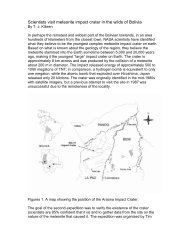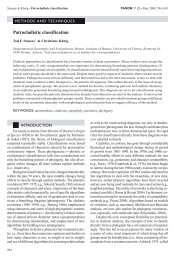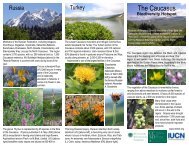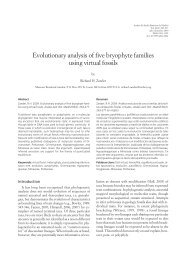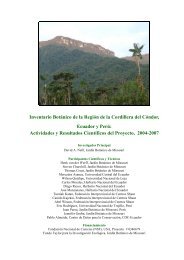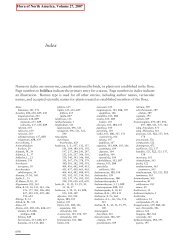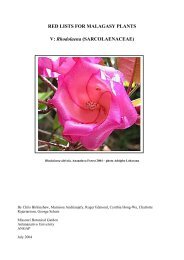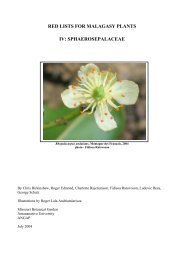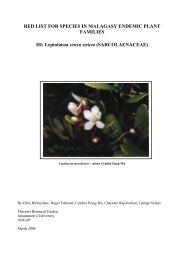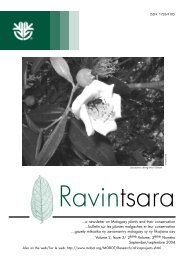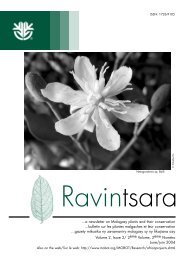phylogeny of campanulaceae s. str. inferred from its sequences of ...
phylogeny of campanulaceae s. str. inferred from its sequences of ...
phylogeny of campanulaceae s. str. inferred from its sequences of ...
Create successful ePaper yourself
Turn your PDF publications into a flip-book with our unique Google optimized e-Paper software.
566 Annals <<strong>str</strong>ong>of</<strong>str</strong>ong> the<br />
Missouri Botanical Garden<br />
Species <<strong>str</strong>ong>of</<strong>str</strong>ong> the Campanula s. <strong>str</strong>. clade are mostly<br />
appendiculate, have basal dehiscence, and are cytologically<br />
more homogeneous, particularly those<br />
species in Campanula and Symphyandra. Many <<strong>str</strong>ong>of</<strong>str</strong>ong><br />
them were included in Campanula sect. Medium<br />
(DC.) Boiss. (Boissier, 1875). Much <<strong>str</strong>ong>of</<strong>str</strong>ong> the radiation<br />
<<strong>str</strong>ong>of</<strong>str</strong>ong> this group is associated with the mountain-building<br />
processes <<strong>str</strong>ong>of</<strong>str</strong>ong> Eurasia, <strong>from</strong> the Atlas Mountains<br />
in the west to the western Himalayas. Subcenters<br />
<<strong>str</strong>ong>of</<strong>str</strong>ong> high diversity for the Campanula s. <strong>str</strong>. clade<br />
include the Balkan Peninsula, Anatolia, and the<br />
Caucasus Mountains. Campanula, as it is currently<br />
constituted, is clearly polyphyletic. The more divergent<br />
taxa in this clade are found mainly in the<br />
Mediterranean basin and are placed in small or<br />
monotypic genera (e.g., Azorina, Diosphaera, Edraianthus,<br />
Feeria, and Michauxia). Since De Candolle’s<br />
monograph <<strong>str</strong>ong>of</<strong>str</strong>ong> 1830, Edraianthus has been<br />
associated with the wahlenbergioid group, but it is<br />
clearly campanuloid, although <strong>its</strong> exact relationships<br />
within the Campanula s. <strong>str</strong>. clade remain<br />
unclear (see also Hilliard & Burtt, 1973).<br />
Symphyandra A. DC. is now generally considered<br />
to be artificial (Greuter et al., 1984; Oganesian,<br />
1995), and this analysis supports that conclusion.<br />
However, the four sections <<strong>str</strong>ong>of</<strong>str</strong>ong> the genus<br />
recognized by Fedorov (1957) are all quite distinct,<br />
and we suggest that the species formerly included<br />
in this genus should be re-examined and not necessarily<br />
included in Campanula without substantial<br />
evidence. The generic status <<strong>str</strong>ong>of</<strong>str</strong>ong> Symphyandra odontosepala<br />
(Boiss.) E. Esfandiari (not sampled) and<br />
the Iranian endemic genus Zeugandra P. H. Davis<br />
(not sampled) also need to be reassessed. Symphyandra<br />
h<<strong>str</strong>ong>of</<strong>str</strong>ong>manni Pant. seems to be rather distant<br />
<strong>from</strong> the bulk <<strong>str</strong>ong>of</<strong>str</strong>ong> species in Campanula, whereas S.<br />
pendula (M. Bieb.) DC. and S. armena (Stev.) A.<br />
DC. are much closer.<br />
Several genera may best be regarded as transitional<br />
between the wahlenbergioid group and the<br />
campanuloid group. Musschia is probably better<br />
placed with the campanuloids, but it is somewhat<br />
intermediate morphologically between the two major<br />
porate groups and shows some resemblance to<br />
wahlenbergioids such as Heterochaenia A. DC. <strong>from</strong><br />
Réunion. It does not appear to be close to Platycodon<br />
or Microcodon A. DC. as in the arrangement<br />
<<strong>str</strong>ong>of</<strong>str</strong>ong> Schönland (1889–1894). On the basis <<strong>str</strong>ong>of</<strong>str</strong>ong> ITS sequence<br />
similarity to Gadellia, we suggest that the<br />
distinct morphological evolution <<strong>str</strong>ong>of</<strong>str</strong>ong> Musschia on<br />
Madeira was relatively rapid. Jasione also appears<br />
to be basal within the complex <<strong>str</strong>ong>of</<strong>str</strong>ong> Northern Hemisphere<br />
genera but <strong>its</strong> exact relationships remain<br />
unclear. On the whole it appears to have more affinities<br />
with campanuloid taxa. In the cpDNA tree<br />
<<strong>str</strong>ong>of</<strong>str</strong>ong> Cosner et al. (2004), Jasione forms an unresolved<br />
polytomy with Symphyandra, Edraianthus, Campanula,<br />
and Trachelium.<br />
Chromosome numbers (Fig. 2) are lowest overall<br />
in the colpate/colporate alliance, although the lowest<br />
recorded diploid number is for Jasione (2n <br />
12). Within the Rapunculus clade, with the exception<br />
<<strong>str</strong>ong>of</<strong>str</strong>ong> the clade comprising Adenophora and Hanabusaya,<br />
the chromosome numbers are diverse and<br />
are consistently lower than numbers recorded for<br />
the Campanula s. <strong>str</strong>. clade, which are predominantly<br />
2n 34. If we accept the premise that there<br />
has been a general increase in chromosome number<br />
during the evolution <<strong>str</strong>ong>of</<strong>str</strong>ong> the Campanulaceae, then<br />
the platycodonoids are ance<strong>str</strong>al to all other groups<br />
and the wahlenbergioids and rapunculoids are ance<strong>str</strong>al<br />
to the campanuloids s. <strong>str</strong>. This accords well<br />
with our knowledge <<strong>str</strong>ong>of</<strong>str</strong>ong> pollen morphology and evolution<br />
in the family, as well as the morphology <<strong>str</strong>ong>of</<strong>str</strong>ong><br />
the capsule in the different groups. However, the<br />
diploid number 2n 34 occurs in several unrelated<br />
lineages (Campanula, Nesocodon, Canarina,<br />
and O<strong>str</strong>owskia) and probably evolved independently<br />
in each <<strong>str</strong>ong>of</<strong>str</strong>ong> these genera.<br />
This analysis suggests that the ance<strong>str</strong>al home <<strong>str</strong>ong>of</<strong>str</strong>ong><br />
the Campanulaceae may be in the region <<strong>str</strong>ong>of</<strong>str</strong>ong> eastern<br />
Asia (<<strong>str</strong>ong>of</<strong>str</strong>ong> current geography) (see also Hong, 1995;<br />
Cosner et al., 2004), but such an interpretation cannot<br />
be easily reconciled with the di<strong>str</strong>ibution <<strong>str</strong>ong>of</<strong>str</strong>ong><br />
many genera within the family or with closely related<br />
families such as the Lobeliaceae, Cyphiaceae<br />
s. <strong>str</strong>., or Nemacladaceae (Eddie, 1984, 1997,<br />
1999). Carolin (1978), citing the di<strong>str</strong>ibution <<strong>str</strong>ong>of</<strong>str</strong>ong> Cyananthus<br />
in India, concluded that the Campanulaceae<br />
are essentially an African family that<br />
evolved primarily in western Gondwanaland. Bremer<br />
and Gustafsson (1997), using nucleotide substitutions<br />
in rbcL, suggested an East Gondwanaland<br />
origin at the end <<strong>str</strong>ong>of</<strong>str</strong>ong> the Cretaceous for the asteraceous<br />
alliance <<strong>str</strong>ong>of</<strong>str</strong>ong> families, and that the group subsequently<br />
diversified and expanded to West Godwanaland<br />
before the breakup <<strong>str</strong>ong>of</<strong>str</strong>ong> the supercontinent.<br />
On the basis <<strong>str</strong>ong>of</<strong>str</strong>ong> atpB-rbcL spacer sequence data, E.<br />
B. Knox (pers. comm.) has stated, ‘‘. . . The interpretation<br />
is that Cyphia and the Lobeliaceae originated<br />
in southern Africa because the eight ‘basal’<br />
lineages are entirely or predominantly African, and<br />
many <<strong>str</strong>ong>of</<strong>str</strong>ong> these are re<strong>str</strong>icted to southern Africa.’’;<br />
‘‘. . . The Lobeliaceae, Cyphiaceae, and Campanulaceae<br />
go back at most 40–50 MYA, and I do not<br />
think that the biogeographic patterns can be attributed<br />
to Gondwanaland.’’ If the family had arisen<br />
in Asia one would have expected platycodonoids to<br />
be represented in Eurasia and in North America.<br />
The presence <<strong>str</strong>ong>of</<strong>str</strong>ong> the colporate genus Canarina in





